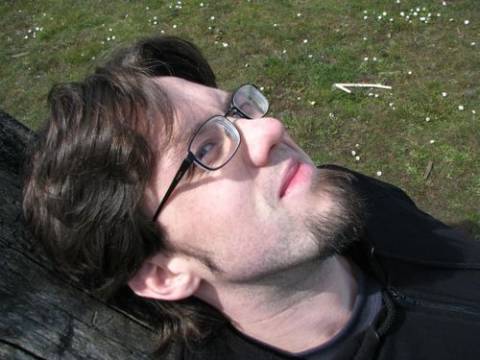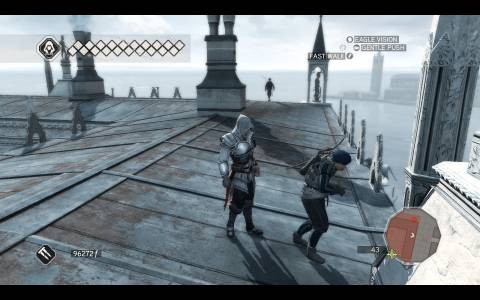
I have a love-and-hate relationship with stealth games, a notion I promptly explained to Mark of the Ninja technical designer and Thief superfan Nels Anderson when I sat down to see his own stealth game at PAX East back in April.
Truly, I want to like them. I love intersecting game systems, which stealth games have in spades. Hitman: Blood Money has been a recent treat, even if that one often underscored my predominant issues with the genre. Too often, I don’t feel as though I have enough readily accessible information to make decisive, meaningful actions in stealth games, unless I spent an inordinate amount of time trial-and-errroring through a space in search of the optimal path.

Our conversation at PAX East wasn’t recorded, so we reconvened on Skype recently, and I laid out my hand-wringing again. Anderson is a connoisseur of the genre but one who's quick to criticize it, too.
“The thing that maybe I love most about stealth game is the broad gameplay flow is all about pull,” he said. “In most games, it’s all about push. The game is sending this encounters onto you and you have to react to them. All you do is react."
In Thief or Hitman, it's the opposite. You're biding your time.
"That delayed gratification can be pretty satisfying," he said. "How much you need to invest to get that and how tolerant people are of that can vary pretty dramatically. I’m totally happy to spend 30, 45 minutes trying to concoct some crazy ass situation in Hitman.”
Mark of the Ninja is a stealth game where you can truly look, feel and act like a stealthy bad ass. The game is constantly feeding you a steady flow kind of environmental information a stealthy bad ass (someone you'd assume is pretty smart) would know and use. When you cause noise, like smacking a gong with a shuriken from way across the room, the sound actually produces a noise cone on-screen, so you know what effect your actions have.
“As we were building the thing and iterating on it," he said, we kind of discovered the more information people had, the more enjoyable it was for them to play the game.”
These are the kinds of granular details that could be gathered by the player if they spent enough time experimenting, but Klei (and I’m with them here) would rather see the player spend that time employing their ideas--and succeeding.
“Sometimes [stealth] gameplay ends up being ‘well, I’m going to probe into the black box and see how that system works and poke at this thing here and poke at that thing there’ and start to build a mental model of how these guys work,’ said Anderson. “It can be fun, but that’s totally pitched on this knifes edge, where it’s really, really easy to fall on one side or the other, where it’s way too transparent and you’re just playing the mini-map and that’s boring.”
And before you ask, if you’re a hardcore stealth nut who feels design choices like this are simply to accommodate pansies like yours truly, the game will sport a New Game Plus mode where these systems are turned off.
Part of the reason Mark of the Ninja can show more information to the player is because it’s 2D--it's simpler. There just aren’t very many 2D stealth games, though. Does the Oddworld series count? The only one Anderson could come up with was Trilby: The Art of the Theft, which was made by none other than Ben “Yahtzee” Croshaw. Without other games to look towards, Klei was forced to invent solutions to problems no one else had encountered.
“From the outset, it was definitely not clear that would be a thing that would work,” he said. “It’s good that, ultimately, we figured out enough to put those pieces together...I hope.”
While every developer will tell you they want to break new ground, it’s always nice to have other games to look at for reference, even if it’s only to reaffirm you don't want to head in that direction.
Figuring out what was and wasn't working requires fresh bodies, so Anderson's been recruiting local playtesters in Vancouver through Craigslist. Every week, Anderson posts a message on the service promising $20 and the chance to play an unreleased video game--and a few people show up.

Anderson's goal has been to find people who don’t self-identify as genre fans. A player who loves Assassin’s Creed is probably a fan of stealth mechanics, even if they don’t really know it.
“If it’s not playing towards those people, it’s probably not going to play to people who aren’t inclined to those games, either,” he said.
I’m still not sure how companies like Valve manage to recruit playtesters over and over again and keep them all quiet.
Around this time, we went down a deep rabbit hole about the similarities between most modern horror and stealth games. Both genres fall prey to their most ardent fans. Fans are fans for a reason, however, and have a higher tolerance for bullshit. As someone who plays most horror games, even junk like the recent Silent Hill: Downpour, I’m constantly forced to explain why it’s worth playing an otherwise terrible game for the few bright spots. Downpour was like that.
But flaws and all, stealth and horror represent emotionally charged experiences removed from most games.
“Those are the two styles that are really, basically, the only types of games that aren’t just about being powerful,” he said. “That’s something that I find super interesting. So many games are all about all the balls to all the walls--power fantasy type stuff. [...] Being the most bad ass who’s ever bad assed doesn’t really say a lot of interesting things to me anymore. I think that territory is pretty well understood.”
It's why Anderson plays every stealth game and I play every horror game: a different experience.
A shared problem in each genre is combat. Combat tends to flat-out suck in both, or at least be clunky to the point you wish the developer had just taken it out. Climax successfully experimented with this in Silent Hill: Shattered Memories, and Frictional Games knocked it out of the park in the nightmarish ride Amnesia: The Dark Descent.
When you introduce combat, a mechanic people are intimately familiar with, expectations go up. Having developed Shank and Shank 2, Klei has proven the ability to develop a fast, robust combat system, and while Mark of the Ninja is hardly a combat-focused game, when the player does find themselves in a fight, it feels good.
How to implement combat proved problematic, though. Klei is developing a stealth game, and early on, the more combat that went into Mark of the Ninja, the more people relied on the combat in every presented scenario.
“This is the weird thing about how human brains work,” he said. “If you provide people with a very un-fun but ultimately successful means of doing something, even if you have other, far more interesting but slightly less obvious or successful or repeatable means of accomplishing the same goal, tons of people will gravitate towards the more reliable but totally boring god damn thing!”
I don’t think Anderson is arguing Mark of the Ninja’s combat is un-fun (it’s not, I’ve played it) but the point about player behavior stands. I’ve seen myself slip into similar habits in games of all stripes, stealth or otherwise.
Mark of the Ninja hopes to strike a delicate balance.
You’ll get to play Mark of the Ninja soon. It’s one of the many games slated for “summer” on Xbox Live Arcade.